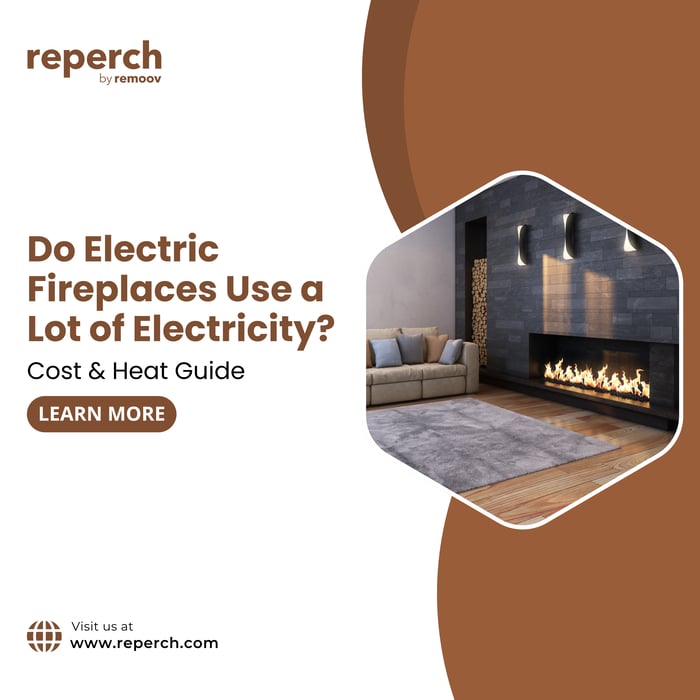Electric fireplaces have become one of the most popular home features for modern buyers and renters alike. They create warmth, ambiance, and a cozy glow without the soot, smoke, or maintenance of wood-burning or gas fireplaces. But a question almost every shopper asks is simple: Do electric fireplaces use a lot of electricity?
The short answer is no, especially when compared with traditional fireplaces. In fact, they are among the most efficient supplemental heaters you can install. Let’s explore how much electricity they actually use, what it costs to run one, and how to get the most comfort for the least energy.
How Electric Fireplaces Work
An electric fireplace doesn’t rely on gas lines, vents, or wood logs. Instead, it runs on electricity to create both realistic flame effects and heat. Inside each unit are two main systems:
Heating Elements: Most models use metal coils or infrared technology to generate heat. A small fan then circulates warm air around the room.
LED Flame Effects: LED lights shine through reflective panels to mimic dancing flames, using minimal power, often less than a standard light bulb.
Because no fuel is burned, nearly 100% of the electricity used is converted into usable heat. That makes electric fireplaces far more efficient than wood or gas models, where most heat escapes through a chimney or vent.
How Much Electricity Does an Electric Fireplace Use?
The exact amount depends on how you use it, but here’s a clear breakdown:
Mode | Average Wattage | Cost Per Hour (at $0.17/kWh) | Monthly Estimate (4 hrs/day) |
Flame-only mode | 50–100 watts | $0.01 | <$1 |
Half heat mode | 750 watts | $0.13 | ~$15 |
Full heat mode | 1,500 watts | $0.26 | ~$31 |
Most standard outlets deliver 120 volts of power, which easily supports a 1,500-watt electric fireplace. If you run it for four hours each day, expect your bill to increase by about $25 to $35 per month. That’s similar to the cost of running a small space heater, but with the added visual appeal of glowing flames.
How Much Heat Do Electric Fireplaces Produce?
Electric fireplaces aren’t designed to heat an entire house, but they’re ideal for “zone heating,” warming the room you’re actually using. A typical 1,500-watt model produces about 5,000 BTUs, which comfortably heats a 400-square-foot room such as a bedroom, office, or living area.
Here’s why zone heating matters:
You can lower your central thermostat and heat only occupied rooms.
You reduce wasted energy by avoiding full-home heating.
You stay cozy while saving on gas or electric furnace use.
The result is better comfort with greater control and lower total energy consumption.
Are Electric Fireplaces Energy Efficient?
Yes, exceptionally so. Here’s why efficiency experts and homeowners alike love them:
Direct heat conversion: Nearly 100% of the electricity becomes heat.
No venting required: Unlike wood or gas fireplaces, no warmth escapes through chimneys or vents.
Adjustable thermostats: Built-in temperature controls help maintain consistent comfort.
Timer functions: Automatic shutoff prevents unnecessary power use.
LED lighting: Long-lasting bulbs create realistic flames using minimal electricity.
If you compare thermal efficiency, the difference is clear:
Type | Efficiency Rate |
Electric Fireplace | Up to 100% |
Gas Fireplace | 70–90% |
Wood-Burning Fireplace | 30–50% |
That means every watt you pay for with an electric model stays inside your room instead of disappearing up a chimney.
Factors That Affect Energy Use
Wattage and Settings: Higher wattage or full-heat modes consume more power. Using flame-only mode drastically cuts consumption.
Frequency of Use: Daily evening use adds more to your bill than occasional operation.
Room Insulation: Well-sealed windows and doors help retain warmth.
Model Quality: High-end units feature thermostats, timers, and eco-modes for optimal control.
Placement: Interior-wall installations retain heat better than those near doors or windows.
Smart Tips to Save Energy
You can easily enjoy the comfort of your fireplace without overspending on electricity. Try these Reperch-approved energy-saving ideas:
Use the timer: Set automatic shut-off during sleep hours or when you leave the room.
Lower your main thermostat: Let the fireplace handle small spaces while reducing central heating.
Run ceiling fans on low: Circulate warm air evenly to reduce runtime.
Choose the right size: Match fireplace wattage to your room size for balanced performance.
Clean the vents: Regular dust removal improves airflow and heating efficiency.
Opt for models with eco-mode: These automatically adjust output for minimal energy use.
Cost Comparison: Electric vs. Gas or Wood Fireplaces
Feature | Electric Fireplace | Gas Fireplace | Wood Fireplace |
Installation Cost | Low (plug-in or built-in) | High (requires gas line) | High (requires chimney) |
Operating Cost | ~$30/month | ~$40–$60/month | Variable, depends on wood prices |
Maintenance | Minimal | Annual inspections | Regular cleaning, ash removal |
Safety | Cool-to-touch surface | Open flame, gas leaks possible | Open flame, smoke risk |
Energy Efficiency | Up to 100% | 70–90% | 30–50% |
Electric fireplaces clearly deliver the best mix of affordability, safety, and efficiency. Plus, they work in any home or apartment without needing special hookups.
Why Homeowners Love Electric Fireplaces from Reperch
At Reperch, we often see customers choosing electric fireplaces as part of their secondhand or vintage furniture upgrades. Many appreciate that:
Electric fireplaces blend comfort with sustainability, complementing the Reperch mission of reuse and waste reduction.
Our curated selection of TV stands with built-in fireplaces lets you add both function and ambiance to your home.
Each piece is inspected for safety, quality, and energy efficiency, ensuring long-term reliability.
Whether you’re refreshing your living room or staging your home for sale, pairing modern electric fireplaces with pre-owned furniture can create a stylish, energy-conscious space.
Final Thoughts
So, do electric fireplaces use a lot of electricity? Not really. When used wisely, they are one of the most cost-effective and energy-efficient ways to add warmth and atmosphere to your home.
A 1,500-watt unit costs roughly $1 per day to operate, delivers enough heat for a medium-sized room, and can even help lower your overall heating bill through targeted zone heating.
For anyone looking to combine comfort, sustainability, and timeless design, an electric fireplace is a smart investment, and Reperch can help you find the perfect piece to match your home and lifestyle.








